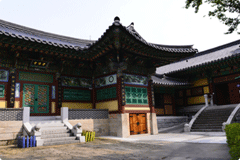Cheongnyangsa
Welcome to Dongdaemun-gu

Cheongnyangsa is a Buddhist temple for female monks, located at 61 Cheongnyangni Dong, on the southern foot of Cheonjangsan. The temple, which is said to have been built in the last days of Silla, was also a special place where King Yejong of Goryeo allowed Lee Ja-hyeon to stay. The ‘Gyeongjo’ part of Daedongyeojido, a map of Korea drawn by Kim Jeong-ho, shows that there was a temple for female monks called ‘Dolgoji Seungbang’ on the western foot of Cheonjangsan, and Cheongnyangsa was located on the southern part of the mountain. Dolgoji Seungbang, one of the four temples for female Buddhist monks that existed in Joseon outside the walls of Seoul, was relocated to the present-day site of Cheongnyangsa as Hongneung, the grave of Queen Myeongseong, came to be built on that site. Cheongnyangsa was a place the dwellers of the city would visit for relaxation and recreation in late Joseon. It was also visited by many patriotic Buddhist monks and leaders when the nation’s fate was threatened by Japanese imperialism. Manhae Han Yong-un, one of the most respected leaders of the national independence movement and a renowned Buddhist scholar, also stayed at Cheongnyangsa briefly. A small gathering was held at this place to celebrate Han’s sixtieth birthday on July 12, 1939. Park Han-yeong, another Buddhist scholar, also stayed in this temple around the same time. The calligraphy on the sign of Cheongnyangsa was written by him.
